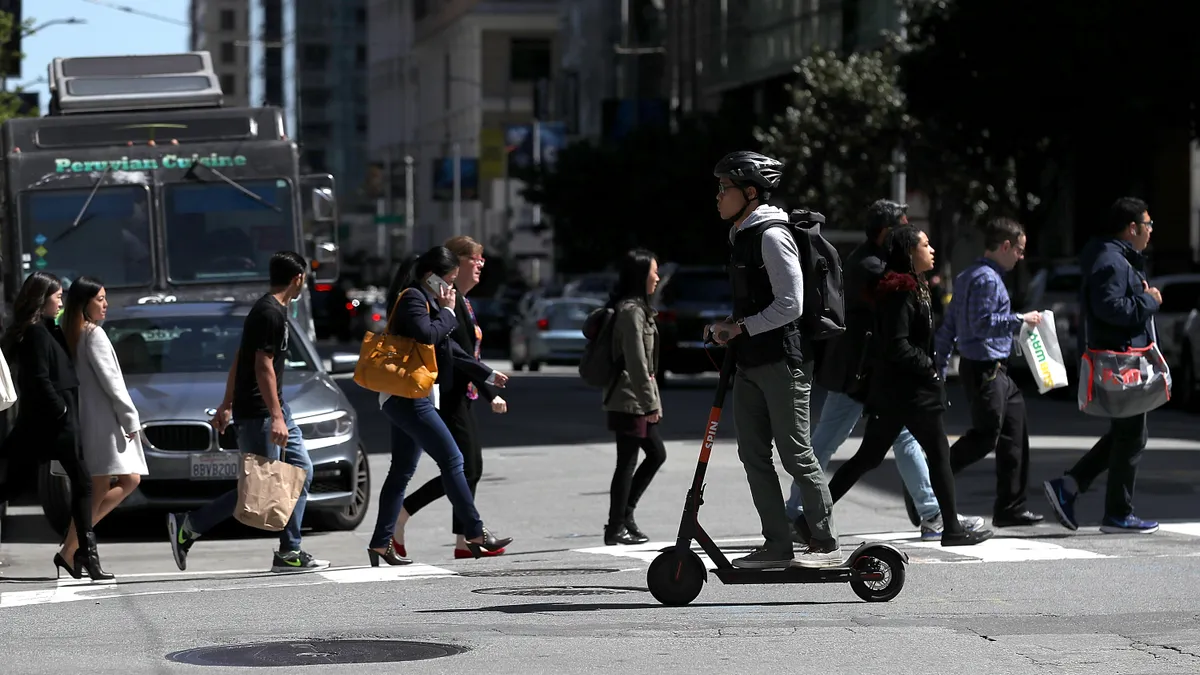As the presence of electric scooters continues to grow in U.S. cities, so do the safety risks that come with them.
The number of e-scooter-related emergency room visits in the U.S. has surged by nearly 450% from 7,700 in 2017 to 42,200 in 2021, according to a recent report from the U.S. Consumer Product Safety Commission. And those estimates likely represented an undercount, the federal agency added.
The vehicles can become safety hazards for many reasons, such as when they obstruct sidewalks when parked, are used by riders who are inexperienced, distracted or impaired, and when colliding with cars or pedestrians on sidewalks or roadways, according to a report published by the National Academies of Sciences, Engineering, and Medicine and the Transportation Research Board.
“Improper e-scooter parking creates risks for people using wheelchairs; pedestrians; older adults; people who are blind or have low vision; and pedestrians living in areas with limited sidewalk space, which may include low-income and minority communities,” stated the TRB report written by researchers from the University of North Carolina, the University of Tennessee, Populus, Safe Streets Research and Consulting and Equitable Cities.
Scooters “have the right to the road, and planners, law enforcement, transportation departments and others need to recognize this mode of transportation and incorporate [it] into their work,” said Pam Shadel Fischer, senior director of external engagement at the Governors Highway Safety Association.
Scooter-sharing programs have experienced an exponential adoption rate since 2016, according to Grand View Research, a market research and consulting firm. Grand View Research expects the market to grow by 7.8% between 2022 and 2030.
But a smaller share of riders is taking precautions as e-scooters grow in popularity. According to the TRB report, few riders wear helmets, even though they prevent injury. Based on its review of 307 e-scooter injury cases, The CPSC estimates that 52% had worn a helmet. Regardless, most e-scooter injuries to riders occurred on the head or upper body, though most “were low severity,” the TRB report stated.
Infrastructure can also factor into safety, as evidence shows that jurisdictions with more extensive bike lane networks were safer for e-scooter use, the TRB report stated. Many accidents involve physical structures such as curbs, maintenance hole covers and utility poles. In addition, roadway irregularities such as potholes and uneven surfaces are a greater danger to scooter riders than to bicycle riders, according to the report
Research has also found that some people are injured because they are inexperienced. The TRB report cited a study in Austin, Texas, which found that experienced riders crashed less frequently than first-time riders.
Collisions with pedestrians make up a small percentage of e-scooter incidents. And, while relatively few e-scooter crashes involve colliding with an auto, those collisions are more severe, the report stated. When scooter fatalities do occur, cars and trucks are frequently involved.
A number of other conditions can factor into crashes. CPSC found that 21% of victims cited darkness or other visibility problems, and 26% of riders said they were carrying something.
In some cases, defective brakes also contributed to crashes, the CPSC also noted, as did the power going out unexpectedly, throwing the user. To better address safety, Fischer said state legislatures need to take the initiative to write rules so people don't get confused, such as not knowing whether they can ride on the street in one town but not the next. But she also said rules need some flexibility to meet local needs.
“Legislation has to be written to allow for continuing evolution of these devices,” Fischer said. “Every day, there seems to be some new device.”
Fischer also cited a need for better crash data. “Unless there's a crash with a motor vehicle, there's usually not a crash report. Riders hit a pothole, hit a pole, fall down; but they're not reporting these incidents, even if they collide with a pedestrian,” she said. Fischer suggested getting data from the healthcare system about injuries. “Emergency rooms are a great resource,” she said.
GHSA has suggested that new codes are needed to document injuries caused by e-scooters and other new forms of transport.











